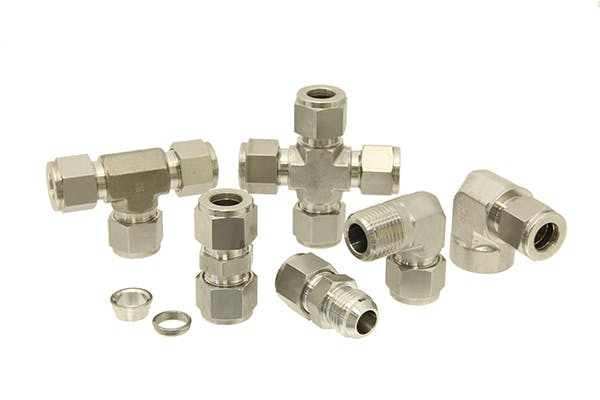Single-Ferrule or Dual-Ferrule – Which One to Use?

Image Description: An image showing Titan Stainless Steel Fittings with Ferrules
In piping, hydraulic, and tubing-based systems, a ferrule is a small yet crucial component used to seal a compression fitting assembly. Compression fittings or pipe fittings are critical elements in a large variety of different tubing-based applications, from plumbing and gas lines to medical devices and chromatography.
Compression fittings are constructed using three key components: a compression nut/screw, a ferrule, and a compression fitting body. Importantly, through radial compression of the components, a leak-tight seal is created between the fitting, ferrule, and tubing.
However, different applications require different types of ferrules. Most significantly, when working with a piping system, it is easy to get confused about whether to use single-ferrule or dual-ferrule for your compression fitting. This article will outline the key differences between single-ferrule and dual-ferrule. By the end, you will have a better understanding of which one to use for what kind of application.
Single-Ferrule
A single-ferrule compression fitting is made up of a single ferrule that grips the tubing and creates a leak-tight seal between the compression nut and the fitting body. In this case, the single-ferrule performs two functions simultaneously: it both seals the fitting and locks it in place.
Moreover, single-ferrules are usually asymmetrical. In a compression fitting with a single ferrule, the nut can transfer torque to the ferrule as it is being tightened, which can cause the ferrule to compress asymmetrically over time. In turn, this can cause problems such as leakages or components that don’t come apart.
Single-ferrules are usually used when the number of components can easily be reduced without compromising the reliability of the seal. For this reason, single-ferrule designs tend to work best when manufactured from soft materials like plastic and brass. The angled front end of the ferrule compresses into the fitting body and grips the tubing.
Generally speaking, single-ferrule designs are better suited for compression fitting applications that vibrate or pulsate a lot.
Dual-Ferrule
A dual-ferrule compression fitting is made up of four components, two of which comprise the ferrule itself. A dual-ferrule, also known as twin-ferrules, comprises two separate ferrules that attach: a front ferrule and a back ferrule.
In compression fitting designs that use a dual-ferrule, the two functions provided by the single-ferrule are distributed among the front and back ferrules. One ferrule seals the fitting while the other one holds it in place.
Double-ferrule designs are typically used in compression fittings that are manufactured using rigid materials such as stainless steel. The symmetrical nature of the dual-ferrule ensures that tightening the nut does not cause asymmetrical compression of the ferrule itself.
Double ferrules come with a front ferrule that compresses into the fitting body and a smaller, freely rotating back ferrule that can easily decouple the nut from the front ferrule. The chemically hardened front edge of the back ferrule can bite down and grip the softer metal of the tubing. This prevents an uneven transfer of torque and protects the system from leakages.
Generally speaking, dual-ferrule designs are better suited for compression fittings that are made for high-pressure applications.
Conclusion
When working with tube fittings for any piping-based application, an appropriate and reliable seal between the various components is necessary to avoid leakages and subsequent damage.
Depending on the nature and purpose of the compression fitting application, either single-ferrule or dual-ferrule can be used. Making the correct choice will ensure that your piping system does not become subject to leakages or damage.